- Details
- Written by: Elmazen
- Category: Flags of Countries of the World
- Hits: 762
Flag of Saint Lucia
Discovering Saint Lucia: Population, Flag, Currency, Borders, Culture, and Attractions
1. Population of Saint Lucia:
Saint Lucia, a beautiful island nation in the Caribbean, has a population of November 2024, approximately 180,000 people.
This relatively small population lives mostly along the coastline and in the capital city, Castries.
Flag of Saint Lucia
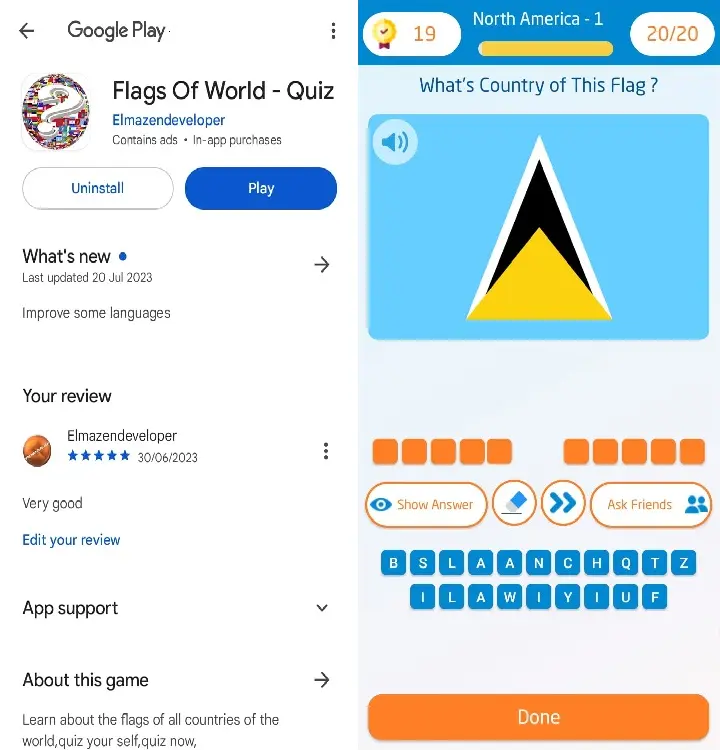
Download the application  Flags Of World - Quiz ,
Flags Of World - Quiz ,
And test your knowledge with Flags of World ,
The population is a diverse mix, with most people being of African descent, alongside smaller communities of East Indian, European, and mixed ethnicities.
2. The Meaning Behind Saint Lucia's Flag:
Saint Lucia's flag is a striking representation of the island's heritage, geography, and aspirations.
The flag features a blue background, a gold isosceles triangle, and a white-edged black arrowhead triangle.
Each color has a unique meaning:
Blue: represents the surrounding Caribbean Sea and the sky, reflecting the island’s connection to water and nature.
Gold: symbolizes the island's abundant sunshine and its natural beauty.
Black and White: represent the harmonious blend of the island’s diverse cultures and races.
Triangles indicate the iconic twin Pitons, two striking volcanic peaks that are a symbol of national pride.
3. Currency of Saint Lucia:
The official currency of Saint Lucia is the Eastern Caribbean dollar (XCD), commonly referred to as the EC dollar.
It is shared with seven other Caribbean nations, including Grenada, Dominica, and Saint Kitts and Nevis.
The EC dollar is pegged to the United States dollar, making it stable and widely accepted across the region.
Flag of Saint Lucia

Download the application  Flags Of World - Quiz ,
Flags Of World - Quiz ,
And test your knowledge with Flags of World ,
4. Saint Lucia’s Borders:
As an island nation, Saint Lucia does not share any land borders with other countries.
Instead, it is bordered by the Caribbean Sea and the Atlantic Ocean.
The island lies to the north of Saint Vincent and the Grenadines, northwest of Barbados, and south of Martinique.
The surrounding waters not only define its geography but also offer exceptional maritime beauty and biodiversity.
5. Culture of Saint Lucia:
Saint Lucian culture is a vibrant blend of African, French, British, and indigenous influences.
The country has a rich history that is reflected in its customs, festivals, and cuisine.
Language: The official language is English, but many locals also speak Saint Lucian Creole (Kwéyòl), a French-based Creole language.
Festivals: Saint Lucians celebrate several colorful festivals, with the annual Saint Lucia Carnival being one of the most anticipated events.
The La Rose and La Marguerite festivals honor the island’s cultural societies and are celebrated with music, dance, and traditional dress.
Music and Dance: Saint Lucia is known for its love of music, with genres like reggae, calypso, and soca being popular.
The island is also famous for hosting the Saint Lucia Jazz and Arts Festival, which attracts international performers and showcases the island’s musical talent.
Cuisine: Saint Lucian food blends African, Caribbean, and French flavors.
Dishes like callaloo soup, green fig and saltfish (the national dish), and bouyon (a type of meat stew) highlight local ingredients and traditional recipes.
6. Best Places to Visit in Saint Lucia:
Saint Lucia’s natural beauty and unique landmarks make it a top Caribbean destination.
Here are some must-visit places:
The Pitons: The twin volcanic spires of Gros Piton and Petit Piton are UNESCO World Heritage sites and symbolize the island’s natural beauty.
Sulphur Springs: Located near Soufrière, these geothermal springs are known as the Caribbean’s only "drive-in volcano," where visitors can experience mud baths with therapeutic benefits.
Pigeon Island National Park: A historic site with military ruins, hiking trails, and stunning beaches, Pigeon Island offers both history and natural beauty.
Marigot Bay: A picturesque bay often described as one of the most beautiful in the Caribbean.
It’s a popular spot for yachting, dining, and relaxation.
Anse Chastanet Beach and Reef: This beach is a prime spot for snorkeling and diving, with vibrant marine life and colorful coral reefs.
Castries Market: For a taste of local life, the market in the capital city, Castries, offers a wide array of local produce, crafts, and souvenirs.
Saint Lucia is a captivating mix of natural beauty, rich cultural heritage, and warm hospitality.
Flag of Saint Lucia

Download the application  Flags Of World - Quiz ,
Flags Of World - Quiz ,
And test your knowledge with Flags of World ,
- Details
- Written by: Elmazen
- Category: Flags of Countries of the World
- Hits: 668
Flag of Saint Kitts and Nevis
Flag of Saint Kitts and Nevis, Currency, Population, Tourist Places, Culture, Borders
Saint Kitts and Nevis: A Caribbean Gem
Saint Kitts and Nevis, a twin-island nation in the Caribbean, is a unique blend of natural beauty, rich history, and vibrant culture.
Known for its lush landscapes, warm people, and stunning beaches, this small country offers a remarkable travel experience.
Here is everything you need to know about Saint Kitts and Nevis, from its population to the best places to visit.
Flag of Saint Kitts and Nevis
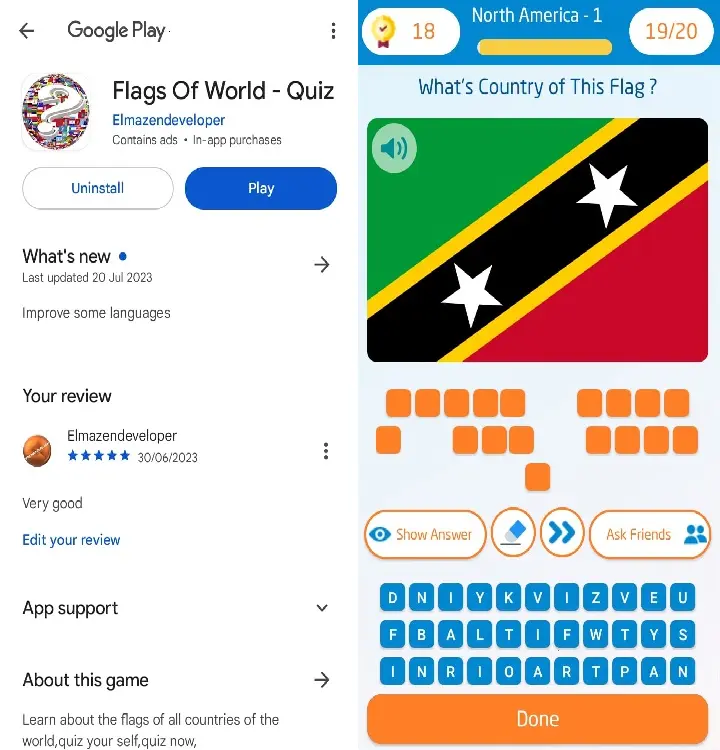
Download the application  Flags Of World - Quiz ,
Flags Of World - Quiz ,
And test your knowledge with Flags of World ,
1. Population of Saint Kitts and Nevis:
As of November 2024, the population of Saint Kitts and Nevis is approximately 46,800 people, making it one of the smallest countries in the Western Hemisphere.
The majority of the population lives on Saint Kitts, while Nevis, the smaller of the two islands, has a more relaxed and rural lifestyle.
2. Saint Kitts and Nevis Flag Meaning:
The flag of Saint Kitts and Nevis features a green, yellow, black, red, and white design.
Here’s what each color symbolizes:
Green: represents the fertile land and lush vegetation.
Red: symbolizes the struggle and sacrifices of the people in their fight for freedom.
Yellow: stands for the sunshine and the bright, optimistic spirit of the people.
Black: represents the African heritage of the majority of the population.
Two white stars: stand for hope and liberty, as well as the two islands that make up the country.
3. Saint Kitts and Nevis Currency:
The official currency of Saint Kitts and Nevis is the **Eastern Caribbean Dollar (XCD)**, which is shared with other members of the Eastern Caribbean Currency Union.
The currency is pegged to the US dollar, making it stable and convenient for visitors from the United States.
Flag of Saint Kitts and Nevis

Download the application  Flags Of World - Quiz ,
Flags Of World - Quiz ,
And test your knowledge with Flags of World ,
4. Borders of Saint Kitts and Nevis:
As an island nation, Saint Kitts and Nevis does not share land borders with any other country.
It is surrounded by the Caribbean Sea and the Atlantic Ocean.
However, it is located near other Caribbean nations, including Antigua and Barbuda to the east and Montserrat to the southeast.
The islands are part of the Leeward Islands in the West Indies.
5. Culture of Saint Kitts and Nevis:
The culture of Saint Kitts and Nevis is a rich blend of African, European, and Caribbean influences.
Music plays a central role, with genres like calypso, soca, and reggae widely enjoyed.
The nation celebrates its heritage through vibrant festivals, the most famous being the **Saint Kitts Music Festival** and the **Nevis Culturama Festival**.
Traditional dances, colorful costumes, and lively street parades are common features of these celebrations.
Cricket is the most popular sport, with both islands having a strong cricketing tradition.
The cuisine is also notable, featuring a mix of Creole flavors with dishes like goat water stew, saltfish, and Johnny cakes.
6. Best Places to Visit in Saint Kitts and Nevis:
There are many beautiful and historic sites to visit on these islands:
Brimstone Hill Fortress National Park (Saint Kitts): A UNESCO World Heritage site with panoramic views and rich history.
Known as the "Gibraltar of the Caribbean".
Mount Liamuiga (Saint Kitts): A dormant volcano offering hiking trails and breathtaking views.
Basseterre (Saint Kitts): The capital city, with a charming mix of architecture, local markets, and scenic waterfront.
Pinney’s Beach (Nevis): A gorgeous sandy beach popular for relaxation and snorkeling.
Nevis Peak (Nevis): A prominent volcanic mountain, ideal for adventurous hikers.
The Scenic Railway (Saint Kitts): A unique railway experience that provides a tour around the island’s lush landscapes and historical sugar plantations.
In Conclusion:
Saint Kitts and Nevis may be small, but it’s a destination full of character, history, and natural beauty.
With its welcoming culture, stunning landscapes, and warm people, it's an ideal place for those seeking both adventure and relaxation in the Caribbean.
Flag of Saint Kitts and Nevis

Download the application  Flags Of World - Quiz ,
Flags Of World - Quiz ,
And test your knowledge with Flags of World ,
- Details
- Written by: Elmazen
- Category: Flags of Countries of the World
- Hits: 673
Flag of Panama
Flag of Panama, Currency, Population, Tourist Places, Borders, Culture
Exploring Panama: Key Facts and Highlights
Panama, a country known for its tropical beauty and the world-famous Panama Canal, bridges Central and South America and offers a unique blend of cultural diversity and natural wonders.
Here’s an in-depth look at some key aspects of Panama, from its population to its cultural richness and stunning tourist attractions.
Flag of Panama
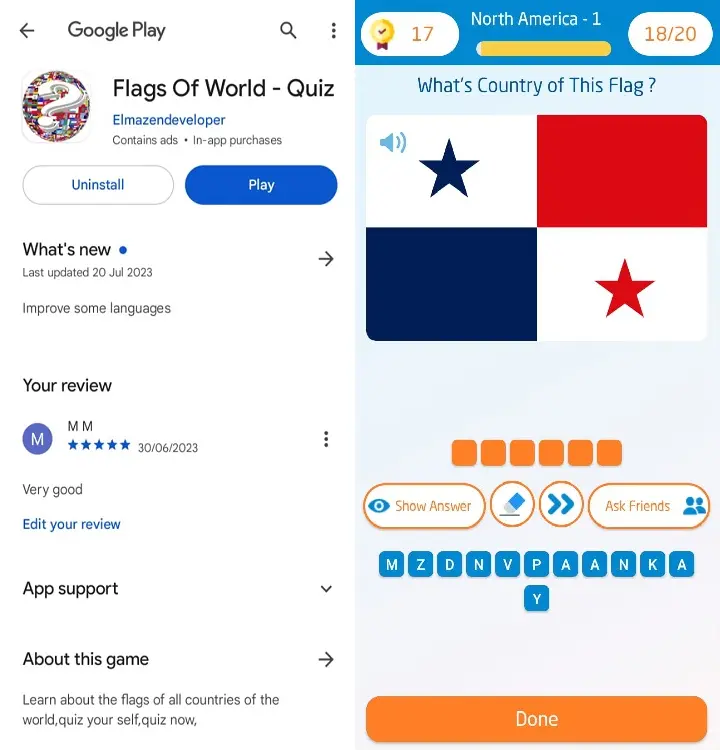
Download the application  Flags Of World - Quiz ,
Flags Of World - Quiz ,
And test your knowledge with Flags of World ,
1. Population of Panama :
As of November 2024, Panama has a population of around **4.53 million people**.
The population is concentrated primarily in urban areas, with a large portion residing in the capital, Panama City.
Panama has a mix of ethnic groups, including mestizo (mixed European and Indigenous heritage), Indigenous, Afro-Caribbean, and European descent, reflecting the country's history as a crossroad for cultures and peoples.
2. The Meaning of the Panama Flag:
The **Panama flag** is simple yet symbolic, divided into four sections with two stars.
Here’s what each part represents:
White: symbolizes peace.
Blue: represents the country's conservative political party and the Pacific Ocean.
Red: symbolizes the liberal party and the Caribbean Sea.
Two stars: The blue star symbolizes purity and honesty, while the red star represents strength and law.
This design reflects Panama's history of political diversity and its strategic location connecting two oceans.
3. Currency of Panama:
Panama’s official currency is the **Panamanian Balboa (PAB)**, named after Spanish explorer Vasco Núñez de Balboa.
The Balboa is pegged to the U.S. dollar, and the two are used interchangeably throughout the country.
In fact, U.S. coins are widely accepted in Panama, making it a convenient destination for American tourists.
Flag of Panama

Download the application  Flags Of World - Quiz ,
Flags Of World - Quiz ,
And test your knowledge with Flags of World ,
4. Panama’s Borders:
Panama is strategically located between Central and South America.
It borders:
Costa Rica: to the west,
Colombia: to the southeast,
It also has coastlines on two major bodies of water:
The **Caribbean Sea** to the north,
The **Pacific Ocean** to the south,
This unique geographic position has made Panama a vital transit point throughout history, both for trade and culture.
5. Culture of Panama:
Panama’s culture is a vibrant mix of Indigenous, Spanish, African, and North American influences.
Some highlights include:
Music and Dance: The national dance is the "tamborito," which blends Indigenous, Spanish, and African rhythms.
Reggaeton and salsa are also popular, especially in urban areas.
Food: Panamanian cuisine incorporates local ingredients with influences from Afro-Caribbean and Spanish cooking.
Dishes like "sancocho" (a chicken stew) and "ceviche" (marinated fish) are popular staples.
Festivals: Panamanians celebrate a variety of festivals, including Carnival, one of the most famous celebrations in the region, and Independence Days honoring separations from Spain and Colombia.
6. Best Places to Visit in Panama:
Panama boasts diverse attractions, from pristine beaches to bustling cities and ancient ruins.
Here are some of the must-visit places:
Panama Canal: This iconic engineering marvel connects the Atlantic and Pacific Oceans and is one of the most impressive sites in the country.
The Miraflores Locks offer a great viewing platform for visitors.
Casco Viejo: Panama City's historic district is a UNESCO World Heritage site filled with colorful architecture, charming plazas, cafes, and churches, offering a glimpse into the country’s rich history.
San Blas Islands: A paradise for beach lovers, the San Blas Islands are known for crystal-clear waters, white sandy beaches, and the Guna Indigenous culture.
Boquete: Located in the highlands, Boquete is a favorite destination for eco-tourists, famous for coffee plantations, hiking trails, and the Baru Volcano, Panama's highest peak.
Bocas del Toro: Known for its vibrant nightlife, beautiful beaches, and opportunities for snorkeling and diving, Bocas del Toro is a popular destination on the Caribbean coast.
El Valle de Antón: Nestled in the crater of an extinct volcano, this town is known for its cool climate, natural hot springs, waterfalls, and a famous market selling crafts and local produce.
From natural wonders to vibrant cultural experiences, Panama is a country that offers a rich mix of history, stunning landscapes, and dynamic modern life.
Whether you’re drawn by its diverse culture, scenic beauty, or the famous Panama Canal, this unique nation has something special for every visitor.
Flag of Panama

Download the application  Flags Of World - Quiz ,
Flags Of World - Quiz ,
And test your knowledge with Flags of World ,
- Details
- Written by: Elmazen
- Category: Flags of Countries of the World
- Hits: 688
Flag of Nicaragua
Exploring Nicaragua: Population, Flag, Currency, Borders, Culture, and Top Attractions
Nicaragua, the largest country in Central America, is known for its vibrant culture, stunning landscapes, and warm, welcoming people.
Here’s an overview of Nicaragua's population, national symbols, culture, and top destinations for travelers.
Flag of Nicaragua
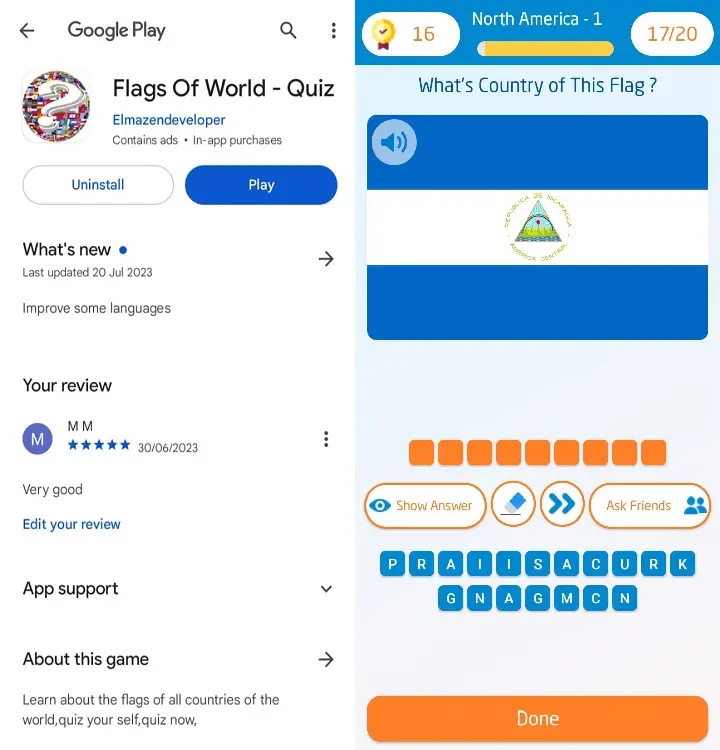
Download the application  Flags Of World - Quiz ,
Flags Of World - Quiz ,
And test your knowledge with Flags of World ,
1. Population of Nicaragua:
As of November 2024, Nicaragua has a population of approximately 6.94 million people.
The majority of Nicaraguans live in urban areas, with Managua, the capital and largest city, being home to over a million residents.
Nicaragua has a youthful demographic, with a significant portion of the population under the age of 30.
2. Nicaragua’s Flag and Its Meaning:
The flag of Nicaragua features three horizontal stripes - two blue stripes on the top and bottom, and a white stripe in the center.
The blue stripes represent the Pacific Ocean and the Caribbean Sea, which border the country.
In the center of the white stripe, the national coat of arms is displayed, featuring symbols that reflect Nicaragua's heritage and natural beauty.
The coat of arms shows a triangle symbolizing equality, five volcanoes representing the unity of Central American countries, a rainbow for peace, and a Phrygian cap, symbolizing liberty.
3. Currency of Nicaragua:
The official currency of Nicaragua is the Nicaraguan córdoba, abbreviated as NIO or C$.
Named after the Spanish conquistador Francisco Hernández de Córdoba, the córdoba is used for most transactions in the country.
U.S. dollars are also widely accepted, especially in larger cities and tourist areas.
Flag of Nicaragua

Download the application  Flags Of World - Quiz ,
Flags Of World - Quiz ,
And test your knowledge with Flags of World ,
4. Borders of Nicaragua:
Nicaragua is located in Central America and shares borders with Honduras to the north and Costa Rica to the south.
To the east lies the Caribbean Sea, and to the west, the Pacific Ocean.
This unique positioning gives Nicaragua a diverse range of landscapes and ecosystems, from coastal beaches to mountainous regions.
5. Culture of Nicaragua:
Nicaraguan culture is a rich blend of indigenous, Spanish, and African influences.
Family and community play a central role in Nicaraguan society, and many celebrations are deeply rooted in religious traditions, especially Roman Catholicism.
Traditional music includes marimba and folk genres, and dance is integral to many celebrations.
The "Palo de Mayo" dance, a traditional Afro-Caribbean dance, is particularly popular on the Caribbean coast.
Nicaraguan cuisine includes staples such as rice, beans, plantains, and corn, with dishes like "gallo pinto" (rice and beans) and "nacatamal" (a type of tamale) being national favorites.
6. Best Places to Visit in Nicaragua:
Nicaragua is a country full of natural wonders, historic cities, and charming towns.
Some must-see destinations include:
Granada: Known for its architecture and colorful buildings, Granada is one of the oldest cities in the Americas and offers visitors a chance to explore Nicaragua’s Spanish heritage.
León: Another city, León is famous for its art, political history, and vibrant culture.
The León Cathedral, a UNESCO World Heritage site, is a stunning example of Baroque architecture.
Ometepe Island: Located in Lake Nicaragua, Ometepe is formed by two volcanoes, Concepción and Maderas, making it a great spot for hiking, swimming, and wildlife watching.
Masaya Volcano National Park: Known as the “mouth of hell,” Masaya Volcano is one of the few volcanoes in the world where visitors can look into an active lava-filled crater.
San Juan del Sur: A picturesque beach town on the Pacific coast, San Juan del Sur is popular for surfing, fishing, and its laid-back vibe, making it a favorite for tourists and expats alike.
Corn Islands: Located off Nicaragua’s Caribbean coast, Big Corn and Little Corn are tropical paradises known for their turquoise waters, white sandy beaches, and coral reefs ideal for diving and snorkeling.
From its cultural richness to breathtaking landscapes, Nicaragua offers a truly unique experience for travelers.
Whether exploring cities, relaxing on Caribbean beaches, or hiking active volcanoes, Nicaragua has something for everyone.
Flag of Nicaragua

Download the application  Flags Of World - Quiz ,
Flags Of World - Quiz ,
And test your knowledge with Flags of World ,
- Details
- Written by: Elmazen
- Category: Flags of Countries of the World
- Hits: 700
Flag of Mexico, Currency, Population, Tourist Places
Exploring Mexico: Population, Flag, Currency, Borders, Culture, and Top Destinations
Mexico, a vibrant country rich in history, culture, and breathtaking landscapes, stands out as one of the world’s most intriguing destinations.
Here, we dive into key aspects of this remarkable country, including its population, flag, currency, borders, cultural identity, and top places to visit.
Flag of Mexico
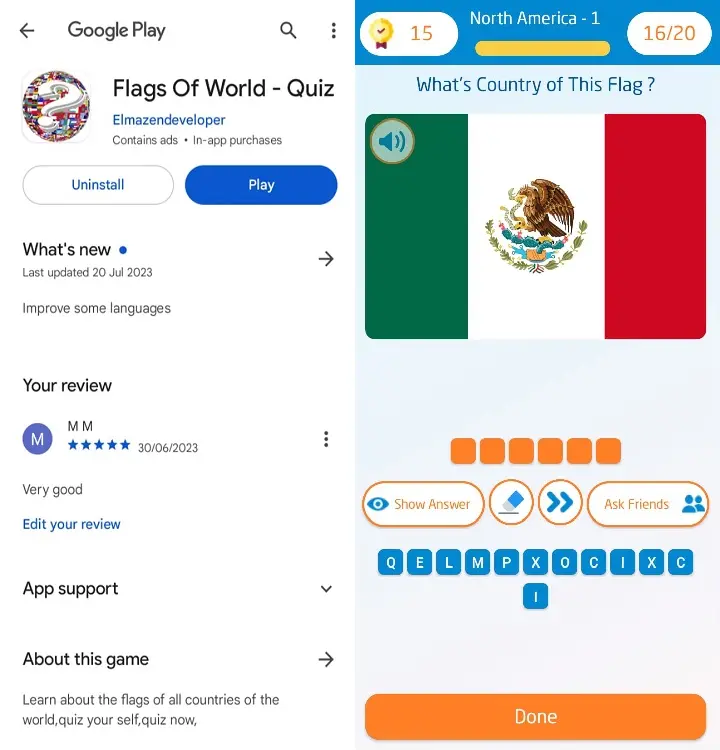
Download the application  Flags Of World - Quiz ,
Flags Of World - Quiz ,
And test your knowledge with Flags of World ,
1. Population of Mexico:
As of November 2024, Mexico has a population of around 131.24 million people, making it the most populous Spanish-speaking country and the 10th most populous in the world.
The majority of Mexicans live in urban areas, with Mexico City, the capital, being one of the most populous cities globally.
2. Mexico’s Flag and Its Meaning:
Mexico’s flag consists of three vertical stripes in green, white, and red, with the country’s coat of arms in the center.
Each color holds specific meaning:
Green: represents hope and independence.
White: symbolizes purity and unity.
Red: stands for the blood of national heroes who fought for Mexico's independence.
The coat of arms in the center depicts an eagle perched on a cactus with a snake in its beak, which is a scene from Aztec mythology that signifies the founding of the Aztec capital, Tenochtitlán (modern-day Mexico City).
3. Currency of Mexico:
The official currency of Mexico is the **Mexican Peso (MXN)**.
The peso symbol is "$," similar to the US dollar.
It is widely used throughout the country and has denominations in both coins and banknotes.
Flag of Mexico

Download the application  Flags Of World - Quiz ,
Flags Of World - Quiz ,
And test your knowledge with Flags of World ,
4. Mexico’s Borders:
Mexico is located in North America and shares borders with:
The United States to the north,
Belize and Guatemala to the south,
The Pacific Ocean to the west and southwest,
The Gulf of Mexico and the Caribbean Sea to the east and southeast.
5. Culture of Mexico:
Mexico boasts a rich, diverse culture influenced by indigenous civilizations like the Aztecs, Mayans, and Zapotecs, as well as Spanish.
Mexican culture is celebrated for its traditions in art, music, and cuisine.
Mexican music includes traditional genres like mariachi, banda, and ranchera, while Mexican art is renowned globally, with artists like Frida Kahlo and Diego Rivera celebrated worldwide.
The cuisine is equally famous, with dishes like tacos, tamales, mole, and enchiladas enjoyed worldwide.
Mexican festivals, such as **Día de los Muertos (Day of the Dead)** and **Cinco de Mayo**, are widely recognized and reflect the country's vibrant traditions and deep respect for family and ancestors.
6. Best Places to Visit in Mexico:
Mexico offers a wide variety of landscapes, from beaches to ancient ruins, bustling cities to natural wonders.
Some must-visit destinations include:
Mexico City: The capital is rich in museums, parks, historical landmarks like the Zócalo, and neighborhoods like Coyoacán and Roma.
Chichen Itza: Located in the Yucatán Peninsula, this UNESCO World Heritage site is one of the New Seven Wonders of the World and an important Mayan archaeological site.
Cancún and Riviera Maya: Famous for their beautiful beaches and vibrant nightlife, they’re ideal for relaxation and water activities.
Tulum: Known for its stunning beachside ruins, clear waters, and bohemian atmosphere.
Oaxaca: This cultural city is known for its colorful architecture, unique cuisine, and festivals.
Copper Canyon: Located in northern Mexico, this series of canyons is larger and deeper than the Grand Canyon, offering incredible hiking trails and scenic views.
Guanajuato: A picturesque city with colorful buildings, narrow streets, and historic sites, perfect for history and architecture enthusiasts.
Summary:
Mexico is a fascinating country with a rich cultural tapestry and stunning natural beauty.
Whether you're drawn by its ancient history, delicious cuisine, or diverse landscapes, Mexico offers something unique for every visitor.
Flag of Mexico
